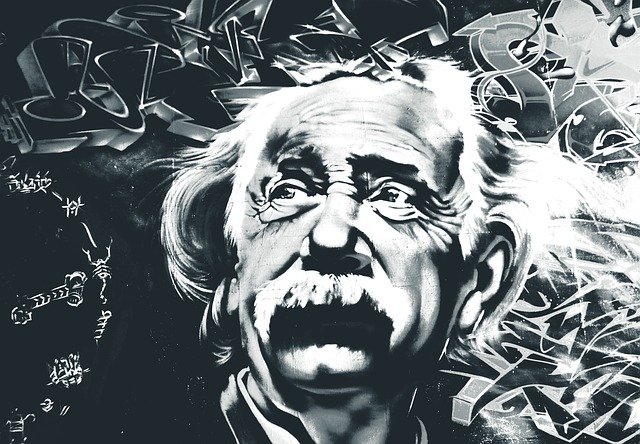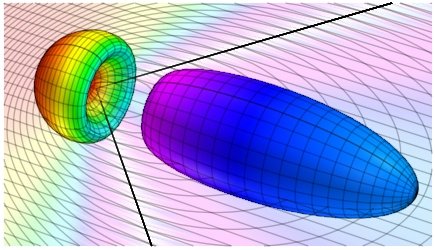Can we talk about something faster than light? Definitely not Usain Bolt.
When Usain St Leo Bolt stunned the world scene in the 2008 Summer Olympics by setting a new Olympic and world record for the fastest 100 metres run at 9.69 seconds, along with a couple other records in that event, we instantly knew that we were in for a ride with the ever-lively Jamaican. By the time he broke his own record at the 2009 Berlin World Championship by winning the 100 m final in 9.58 seconds, the name “Lightning bolt” had been given to the fastest man the world has ever known.
 You can't catch me!
(License: Public Domain]: Pixabay
You can't catch me!
(License: Public Domain]: Pixabay Okay that title might be quite far-fetched when you consider that “light” has been measured to travel at 299,792, 458 m/s. But common, his accolades are duly deceived. The fastest time recorded for a Cheetah was 5.95 seconds for 100 metres. An average person would cover the same 100 m at an average time of about 25 seconds. Well, except you are being chased by a Cheetah, then we wouldn’t even be able to measure your speed as you won’t make it to the 100 m mark. But then again, fear can do the impossible.
Light is a really hard guy to beat when it comes to the Universal Olympics. Faster-than-light entities have continued to be at best applied to fiction. In fact, so long as mass is involved, there is no known possibility of an entity moving faster than light. Not even your dear Superman or Flash of DC comics.
Why is light still the undisputed universal championship when it comes to the Universal Olympics race tracks? Are there possibilities of discovering particles that could outpace the speed of light? What is going to be the implication of the existence of such particles to our world? You care to find out? Lego!
The Speed of Light: A Brief History
 Thought of Light
(License: Public Domain]: Pixabay
Thought of Light
(License: Public Domain]: Pixabay I’m going to be sincere with you, history classes bore the hell out of me. So if you’re anything like me, put on your Kyle XY hats and let’s try to run through this part with the speed of light. If you are nothing like me, I’ve tried my best to make sure you are not disappointed. Here we go…
The discourse between ancient Greek philosopher, Aristotle and Scientist, Empedocles goes down in history as the first recorded on the speed of light. Aristotle disagreed with Empedocles’ assertion that light has a finite speed. Empedocles proposed that since light moved, it must travel with respect to time. Aristotle in turn contradicted him by stating that light travels instantaneously and that is not movement.
In relatively recent history, the likes of Isaac Beckman (1629), Galileo Galilei (1638) and Accademia del Cimento (1667) tried to carry out experiments to measure the velocity with which light travels but to no reasonable avail. The best the Galileo lantern experiment could achieve was to prove that light travels at least 10 times faster than sound.
Danish Astronomer, Ole Romer (1676) made the first quantitative measurement of the velocity of light through his observation of the eclipse of Jupiter’s moon, Lo. He discovered from his observations that light travelled with time from Lo to Earth and it crosses the Earth’s orbit in 22 minutes. He then also determined that light travels from the sun to earth in 10 to 11 minutes. This was however an overestimate.
Scientists afterwards were able to measure the distance between the sun and the earth and combine the result of the measurement (149.6 million km) with Romer’s demonstrated time to arrive at a value of about 220,000 km/s as the velocity of light (still wrong). More notable scientists such as Christiaan Huygens and Isaac Newton tried to use Romer’s work to give a proper estimate of the speed of light, with James Bradley (1704) coming quite close with his study of stellar aberration to estimate that light travels from the Sun to Earth in 8 minutes and 12 seconds (He was 7 seconds short), putting the speed of light at a close 301,000 km/s (185,000 miles per second).
Albert Michelson came closest in 1879, achieving a value of 299.910 km/s (186,355 miles per sec) which was generally accepted as the velocity of light until the mid-1970s when the precise value was found to be 299,792,458 m/s (299,792.458 km/s , 186282.397 miles per sec).
Einstein came into the picture and showed us why light is the Universal speed limit
 Einstein Street Guy!
(License: Public Domain]: Pixabay
Einstein Street Guy!
(License: Public Domain]: Pixabay Albert Einstein must be looking at me from wherever he is now and wondering how a piece of shit like me happens to share the same birthday with him (March 14th). I’m not sorry Albert, I’m really not cut out for most of these shitty things. I just want to play football!
After James Maxwell (1865) proposed in his theory of electromagnetism that light was an electromagnetic wave which travels at a speed c, Albert Einstein (1905) came into the picture with his theory of special relativity and the world never remained the same.
Einstein established in his special relativity theory that the speed with which light travels is constant irrespective of time, position or speed of the observer. He calculated that light travels with the same speed to every observer, be it one standing on the earth’s surface or one travelling in a supersonic jet above the earth’s surface. This made the speed of light c the Universal speed limit, valued at exactly 299,792,458 m/s (about 186,282.397 miles per second). A little short of a perfect figure of 300,000,000 m/s but that could have only made it easier for someone like me to remember.
This mind-blowing speed is best practically described below;
If you travel around the earth’s equator at the speed of light you will travel around the entire planet earth 7.4 times in approximately one second. Source
Note: The c value velocity of light is however only constant through a vacuum like empty space and can be decreased when light travels through a region containing matter (like through water) as the light would have to bend upon coming in contact with the particles.
Albert Einstein’s theory of general relativity further proved why no object can travel faster than light. According theory, the mass of an object gets heavier as its speed increases while its length reduces. By the time an object gets to the speed of light, the mass of the object would be infinite while its length would be zero. This is something that is practically impossible to attain and as such, no known object can reach the speed of light.
As objects travel faster and faster, they get heavier and heavier – the heavier they get, the harder it is to achieve acceleration, so you never get to the speed of light. Source
Light itself is not affected by this because it is made up of photons and these photons, unlike electrons, have no mass. So for an object to even think of attaining the speed of light, it has to be massless. We’ve not started talking about surpassing it yet.
Leo Messi and Cristiano Ronaldo: GOAT contenders
 I am the greatest!
(License: Public Domain]: Pixabay
I am the greatest!
(License: Public Domain]: Pixabay “Hol up! How did we go from talking about Einstein and the speed of light to talking about football?” “Chill bro, this is my own theory of general realeightyveety”
Let me quickly run you through an analogy with my favourite sport if you don’t mind. If you do mind however, just skip to the last paragraph of this section. But why would you want to do that? :p
When I said earlier that I hated history, football (or soccer, for my American folks) was exclusive to that statement.
You see, after the exploits of the legends we know as Pele and Maradona between the '50s and '80s, the footballing community knew that the crown of the Greatest Of All Time (GOAT) had to be between the both of them. This title had been between those two guys for over 35 years until the last decade when Cristiano and Messi came into the picture. And boy believe you me when I tell you that opinions have been well and truly splitted.
I am not even going to start an argument about who I think the GOAT is because that is one for another day. I just want to point out that for those 35+ years, great players came and went... the likes of Ronaldo De Lima, Zinediene Zidane, Luis Figo, Thierry Henry, Ronaldinho, etcetera. These were really great players. But there was great and there was the G.O.A.T title. These players, howbeit they tried to, never really got near Pele and Maradona until the arrival of the Leo and Cristiano.
In the same wise, going back to our discussion for today, the speed of light has been the GOAT for well over a century. It has had its challengers over those years but none has managed to really come close to its talent and skill when it comes to the race track. But it seems it is just about to be given a run for its money. Have you heard of tachyons? First, let’s talk about some of the other great guys that tried their bests in the arena of blood and sand!
The guys that tried to be faster than light
 That friend of yours!
(License: Public Domain]: pxhere
That friend of yours!
(License: Public Domain]: pxhere Once again, definitely not our Usain Bolt. I’m not going to discuss much about these great guys (such as neutrinos and the Hadron collider) here. I’ll just point out that most of them have been hindered by Einstein’s postulation. The problem of mass.
Let me quickly share one that really has little or nothing to do with mass before we move to the major contender (tachyons). It’s the theory of quantitative entanglement which is best described by Michio Kaku with the simple analogy below;
Information does go faster than light, but Einstein has the last laugh. This is because the information that breaks the light barrier is random, and hence useless. (For example, let's say a friend always wears one red sock and one green sock. You don't know which leg wears which sock. If you suddenly see that one foot has a red sock, then you know instantly, faster than the speed of light, that the other sock is green. But this information is useless. You cannot send Morse code or usable information via red and green socks.) Source
So you see, the shit heads known as photons and their cocky agent, Einstein always seem to have the last laugh. If you wish to learn about some of the great guys that tried but just couldn’t beat the speed of light, you could visit here afterwards.
The expanding Universe
Though nothing has ever been discovered to practically have a speed faster than that of light because they do not align with the known laws of physics, there are currently some theoretical possibilities that can break this light’s velocity given special circumstances.
We could talk about the continuous expansion of the Universe as galaxies in the Universe keep moving away from one another at a velocity projected to be greater than the speed of light.
This is actually possible because nothing can go faster than light, and since space can be said to consist of nothing, it can expand faster than light can travel. But on this note, I’ll just have to agree with the following statement;
A galaxy on the far side of the universe? That's the domain of general relativity, and general relativity says: Who cares! That galaxy can have any speed it wants, as long as it stays way far away, and not up next to your face. Source
You should too.
TACHYONS: Messi or Ronaldo? Doesn’t matter mate, just give the goddamned light a run for his money!
 Tachyon
(License: CC BY-SA 3.0, Author: TxAlien]: Wikicommons
Tachyon
(License: CC BY-SA 3.0, Author: TxAlien]: Wikicommons The speed of light is the SLOWEST speed possible for tachyons. Now this shit just got real! Tighten your seat-belts.
Tachyons are hypothetical particles that are purported to move faster than the speed of light. The word ''tachyon'' is gotten from the Greek word ''tachus/tachy'' which means "speedy/swift/rapid". E.C.G Sudarshan is likely the first man to be associated with this faster-than-light particles though he used the term meta-particle in his 1962 publication, “Meta Relativity”. Gerald Feinberg then described these particles having imaginary mass with the name “tachyons” in his 1967 paper, “On the possibility of faster-than-light particles".
The theory of relativity makes us understand that E2 - (pc)2 = (mc)2 ...(1)
Where E is the energy of the particle, P is its relative momentum and m is its rest mass.
For the purposes of this explanation, we can use c = 1, giving us;
E2 = p2 + m 2 ...(2)
For a massless particle, E2 = p2 ...(3)
Equation (2) describes slow particles (or bradyon) while the third equation describes objects that move at the speed of light (or luxon). To consider a particle which should move faster than light, i.e with a speed v>c, this would mean that its mass must be imaginary.
let’s look at another fundamental fact of relativity;
E = m[1−(v/c)²]−½ ...(4)
Looking at the above equation, if v > c, the denominator would have the square root of a negative number which is known in mathematics as “imaginary”. (Remember your complex numbers? Good)
Now, since the total Energy E must be real, the numerator of the equation must also have to be imaginary because mathematics also tells us that a pure imaginary number divided by another pure imaginary number gives us a real number. Hence, tachyons must have an imaginary mass.
Another interesting effect of this is, the acceleration of these particles must increase as the energy decreases. That is, E tends to zero as v tends to infinity. As such, tachyons are forbidden from slowing down to anything lower than the velocity of light c as infinite energy would be required to drop its velocity below that of c.
If these particles truly existed, we could be looking into the possibilities of back-in-time-communication. Like, you would be able to communicate with your 12 year-old self from 2002 and tell him not to make the mistake of going to college as you did! This is some really crazy stuff mahn.
Tachyons would have to propagate backwards in time, implying that when they are used to send signals, the signals would be received even before they were created. Can you imagine building a whole new Internet on this phenomena? I’m not even ready yet.
Reasons like this are why, though there’s a theoretical possibility to their existence, that’s the best we can have for now.
How can particles moving faster than light even be seen? Cherenkov Radiation
 Tachyons emitting Cherenkov Radiation.
(License: CC BY-SA 3.0, Author: TxAlien]: Wikicommons
Tachyons emitting Cherenkov Radiation.
(License: CC BY-SA 3.0, Author: TxAlien]: Wikicommons Of course we know that for an object to travel faster than the speed of light, it must have passed an observer before it even gets noticed. So the only way to track such an object is if it leaves any traces along its path. Luckily for us, such objects do.
When charged particles move through a medium at a speed of v>c, they are accompanied by an eerie blue glow known as the Cherenkov radiation emission. It is produced as a by-product of these faster-than-light velocities as the particles associated with them accelerate through the medium. Which, for tachyons, occurs as they lose energy. Though scientists and mere observers alike are yet to find these blue glow to enable us discover the possibilities of the real existence of tachyons, one can however observe the Cherenkov radiation emission in the coolant/moderating water of the Reed Research Reactor in the United States.
Coming to the end of this whole thing, I begin to ask myself, why do we even care if there’s something faster than the speed of light? Well, except the backwards-time-communication prospect it offers. I say let’s allow light to keep running the show. Literally.
I end with this beautiful piece by Reginald Buller
There was a young lady named Bright,
Whose speed was far faster than light.
She went out one day,
In a relative way,
And returned the previous night!
Thanks for reading.
REFERENCES
How Fast Does Light Travel? | The Speed of Light
4 things that currently break the speed of light barrier
The real reasons nothing can ever go faster than light
15 Fastest Things in The Universe
30+ Fastest Things In The World
What Ever Happened to Tachyons?
Do you write STEM (Science, Technology, Engineering, and Mathematics) related posts? Then you should consider joining the #steemSTEM community on discord here. If you are from Nigeria, you should also consider including the #stemng tag in your post. You can visit this blog by @stemng for more details.
Hi
You have received an upvote (from @rycharde) and a resteem (from @accelerator) as part of the new MAP Trail initiative to support curated content.
You can see your entry here and the curator who promoted your post.
All of this is free and part of MAP's mission to support quality content creators by supporting curators.
You may help support the MAP Trail by either upvoting, resteeming or delegating to @accelerator...
... or just upvoting this comment :-)
Duuude, amazing post. You really took me to space with it xd ! It was a blast to read it ! I find amazing how easily you could explain all that ! I'll follow and resteem this post ! Keep the good job! Also, you can take a look at my blog, I am planning to post a lot of physics things too!
Wow! Thanks a lot man.
I'm really glad you enjoyed it
I'm following you now and I hope to see your posts soon. Make sure you use the #steemstem tag for your science related post.
This is actually a mis-conception. Mass is an intrinsic property of an object. What you actually have in mind here is the'relativistic mass' that is nothing but the energy divided by c2.
By the way, tachyons are often the sign that the considered theory is not in its ground state. Like the mass term of the Higgs field of the Standard Model. It is tachyonic unless we observe that at the minimum of the potential, the degrees of freedom are different.
Nice post by the way :)
I have actually been waiting for your comment :)
This is very correct. It never did occur to me.
I'll also need to read about the Higgs field of the standard model. I am not a physicist but someone who just has a small interest in theoretical physics and I'm glad to have learned a lot from this comment.
Thanks for stopping by.
My pleasure! :)
Great write-up. Small correction: the moon's name is "Io", not "Lo"
Thank you very much.
Correction taken!
These subatomic speedsters cannot go faster than the speed of light as it has been proven to be mathematically impossible but hypothetically possible :)
You did an awesome job here. Thank you for sharing.
Thank you for stopping by @greenrun
I appreciate the warm comment :)
You are actually spot on! Einstein's theories still remains undefeated.
You are welcome :D
Man, this was some great read. Never heard of tachyons tbh. Damn, I haven’t enjoyed a physics post for a while like I have enjoyed this. Great stuff man 😎😎
Thanks a lot fam!
Theoretical physics is arguably one of the most fascinating subjects there is.
I appreciate your coming by to read boss.
Theoretical physics is just amazing, articles like this makes you see the world in a different way...great article
I tell you man... a really wonderful course.
Thanks for stopping by.
Hi @writeit!
Your post was upvoted by utopian.io in cooperation with steemstem - supporting knowledge, innovation and technological advancement on the Steem Blockchain.
Contribute to Open Source with utopian.io
Learn how to contribute on our website and join the new open source economy.
Want to chat? Join the Utopian Community on Discord https://discord.gg/h52nFrV
Congratulations! Your post has been selected as a daily Steemit truffle! It is listed on rank 16 of all contributions awarded today. You can find the TOP DAILY TRUFFLE PICKS HERE.
I upvoted your contribution because to my mind your post is at least 20 SBD worth and should receive 159 votes. It's now up to the lovely Steemit community to make this come true.
I am
TrufflePig, an Artificial Intelligence Bot that helps minnows and content curators using Machine Learning. If you are curious how I select content, you can find an explanation here!Have a nice day and sincerely yours,

TrufflePigThis post was shared in the Curation Collective Discord community for curators, and upvoted and resteemed by the @c-squared community account after manual review.